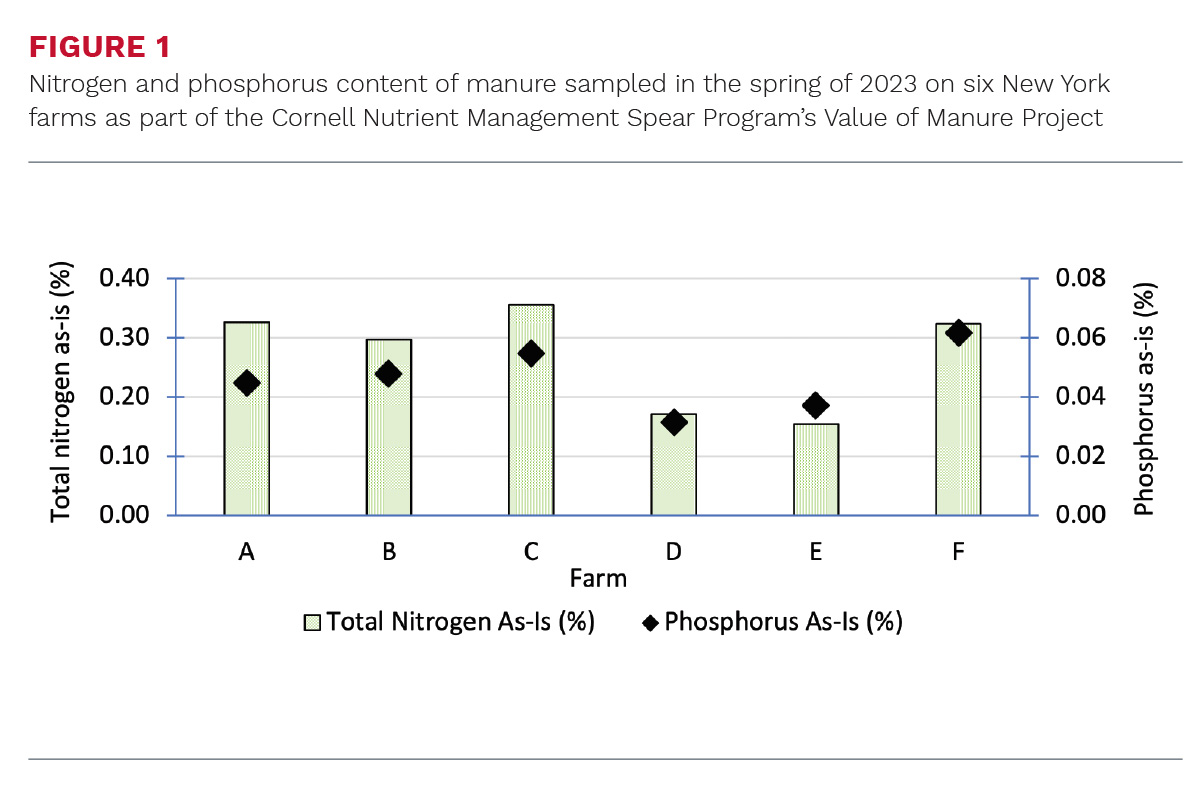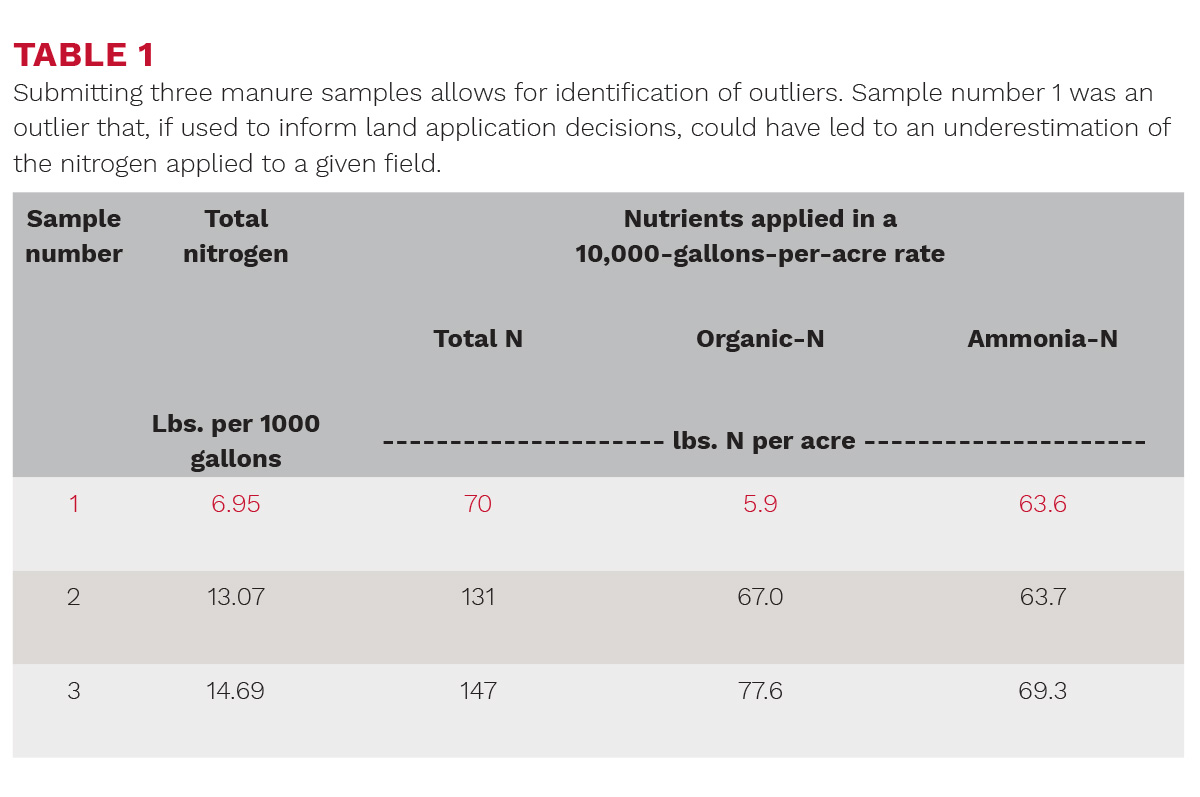Sound land application of livestock manure can reduce or replace fertilizer needs, given that manure contains all 17 essential nutrients for crop growth, and increase soil health over time. Healthier soils are more resilient to extreme weather events, thereby increasing overall farm resilience. A pillar of sound manure management is to understand what is in manure to better plan and manage applications for growing healthy, high-yielding crops profitably while maximizing environmental protection.
MANURE SOURCES
Using manure as a crop fertilizer is not as straightforward as using an inorganic or commercial fertilizer source. Manure nutrient composition can be highly variable, influenced by factors such as animal types and diet, bedding material, manure collection system, storage method, storage time, and manure treatment technologies. Manure management is aimed at optimizing various manure sources for use of nutrients, solids, energy, water, or other components.
Common Northeast dairy manure sources include raw liquid manure, separated liquids, separated solids, and digestate. Dairy manure in its untreated state is typically in liquid form. Separated solids and separated liquids are produced when separation technologies are employed on the farm, such as belt presses, screw presses, inclined screens, and others. Digestate results from anaerobic digestion systems.
Farms can utilize anywhere from zero to four or five interconnected manure treatment technologies, leading to the creation of multiple manure sources. It is essential to treat these sources as unique due to their varying nutrient compositions. Sampling of different manure sources conducted on New York farms during spring 2023 as part of the Cornell Nutrient Management Spear Program’s Value of Manure Project, funded by New York Farm Viability Institute and Northern New York Agricultural Development Program, showed how variable manure nitrogen and phosphorus content can be from one farm and source to another (Figure 1).

PROPER MANURE SAMPLING
To maximize utilization of nutrients in manure, take representative samples and have them analyzed for nutrient and solids content. The best way to take a representative sample is to collect samples just before or during spreading events.
When working with liquid manure and slurries, sample directly from the spreader. Sampling from manure storages, especially when solids have settled at the bottom, is risky as the sample may not be representative for the tanker load that is actually applied to the field. If sampling needs to happen from storages, especially unagitated storages that have layers with significant differences in solids content, each layer should be sampled independently and treated as a separate manure source.
For solid manures, collect four to eight scoops from different places in the spreader. Mix them well and collect samples from the mixed sub-samples. Manure piles present high variability between sections of the pile, so each section should be sampled independently and treated as a different source during application.
Keeping good manure analyses records is essential. With sampling right before or during spreading, laboratory analyses results of the current application are not known until after the application is done. But, use of running three-year averages will help obtain more accurate estimates of nutrient content.
Other tips to take proper manure samples:
- Sample at least once a year and after transfers between storages or other events that could impact nutrient composition. Sampling before any major spreading events during the year is recommended.
- Submit three samples to the laboratory to avoid working with outliers created by sampling and/or processing. Each sample should be analyzed separately and then used to calculate the average manure nutrient content for the manure source that was sampled. If outliers are present (for example, a laboratory analysis with a drastically different solid or organic N content), discard the outlier. Following the example in Table 1, using an N value from an outlier when calculating the value of a 10,000-gallons-per-acre rate would lead to missing around 72 lbs. organic-N per acre, of which 35 percent (25 lbs. of N per acre) is estimated to be crop-available the first year. This difference of 25 lbs. of N per acre can go a long way when making fertilizer decisions for all the acres in the farm!

- Slow down microbial activity by keeping your samples cool after collection and freeze them as soon as possible. Ship frozen samples to the laboratory early in the week to avoid having them sit in the post office over the weekend. If possible, choose a speedy shipping option.
READING AND INTERPRETING A DAIRY MANURE ANALYSIS
Typical manure analyses report the concentration of total N, organic N, ammonium N (also reported as inorganic N), total phosphorus (P) as P and/or P2O5, total potassium (K) as K and/or K2O, and either percent solids or moisture. There are important differences on how organic and inorganic nitrogen behave in the soil and interact with a crop. More information about how to calculate the nutrient credits of each of the N forms is found in “Manure – A valuable nutrient asset” and Cornell Agronomy Factsheet #4. In the case of P and K, nutrient credits should be calculated using P2O5 and K2O (fertilizer equivalence) as this allows for direct comparison to inorganic fertilizer concentrations.
Each of the nutrients in the manure analysis are usually reported as percentage (%), pounds per ton (lbs./ton) for solid manures, and/or pounds per 1,000 gallons (lbs./1,000 gallons) for liquid manure and slurries. Micronutrients in manure are usually reported as parts per million (ppm). Nutrients can be converted from lbs. per ton to lbs. per 1,000 gallons using the density of manure. If a density value is not included in the report, an average value of 8.34 pounds per gallon can be used for dairy liquid manure. See Table 2 for other useful conversion equations. To learn more about interpretation of dairy manure analysis, see Agronomy Factsheet #122.

A QUICKER WAY
For the state of New York, the Value of Manure cellphone app simplifies manure-related calculations (Figure 2). The app uses the manure analysis to calculate nutrient credits, fertilizer value of manure, break-even hauling distance, and nutrient application balances.

SUMMARY
Manure nutrient composition on one farm is going to be different from other farms, with important differences even between storages within an operation as well. Sample manure and have it analyzed for nutrient and solids content to make better informed nutrient management decisions that allow for use of nutrients already on the farm, while decreasing need for purchased fertilizers. Proper manure sampling is key to obtain results that are representative of the nutrient content in manure. With good sampling techniques and frequency, some of the variability out of an inherently variable nutrient source on the farm is removed.
RESOURCES
- Cornell Agronomy Fact Sheets:
- #38: Manure Sampling, Handling and Analysis:
- #4: Nitrogen Credits from Manure
- #122: Reading and Interpreting Dairy Manure Analyses
- Cornell NMSP Value of Manure project
- Recommended Methods of Manure Analysis, Second Edition
- New York NMSP Value of Manure app
- The Manager article “Manure – A valuable nutrient asset
 |
This article appeared in PRO-DAIRY's The Manager in November 2023. To learn more about Cornell CALS PRO-DAIRY, visit PRO-DAIRY. |










